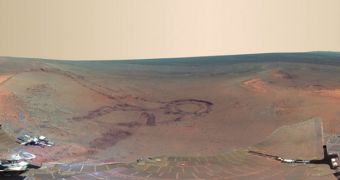Scientists at the NASA Jet Propulsion Laboratory (JPL), in Pasadena, California, have just released a new dataset compiled by the Mars Exploration Rover (MER) Opportunity, which consists of an incredibly beautiful, 360-degree panorama of the robot's current location.
The composite image was stitched together from around 817 individual photographs, snapped by Opportunity between December 21, 2011 and May 8, 2012. During this interval, the machine was mostly stationary, as it preserved its position throughout the Martian winter.
Unlike its former counterpart on the other side of the planet, Spirit, this exploration rover is capable of remaining operational during the winter, even though it cannot move like it does in the summer. Throughout the last winter, Opportunity studied rocks at an outcrop called Greeley Haven.
The panorama reveals some of the tracks left behind by the robot, as well as the massive Endeavour Crater, which has been its target for more than three years. Thus far, the machine has driven in excess of 33 kilometers (21 miles) on the surface of the Red Planet.
On July 2, it managed to complete its 3,000th Martian day of operations. Opportunity arrived on the surface of our neighboring world in January 2004, for a 3-month mission that is carrying on even now.
This milestone also marked another important achievement for NASA – more than 15 years of continued robotic exploration of Mars. This line began when Mars Pathfinder made its way on the Red Planet, on July 4, 1997.
While the mission was still active, the Mars Global Surveyor arrived in orbit. The latter remained in operations until the arrival of Mars Odyssey, the MER rovers, the Mars Reconnaissance Orbiter and the Phoenix Mars Lander. In about a month, the Mars Science Laboratory rover Curiosity will land as well.
Opportunity snapped the images necessary for creating this photograph with its panoramic camera (Pancam), explains the instrument's lead scientist, Arizona State University (ASU) expert Jim Bell.
“The view provides rich geologic context for the detailed chemical and mineral work that the team did at Greeley Haven over the rover's fifth Martian winter, as well as a spectacularly detailed view of the largest impact crater that we've driven to yet with either rover over the course of the mission,” he says.

 14 DAY TRIAL //
14 DAY TRIAL //